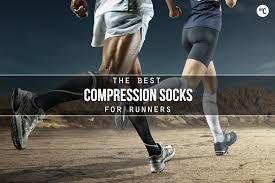
Introduction
Do you enjoy running? Whether you are a casual jogger or professional runner, you may have wondered how you can perform better than your last running session, such as how to improve speed or build endurance.
One way would be to use compression socks as these can increase athletic power, enhance running performance, and speed up recovery post-run.
Curious to find out more? This detailed guide will provide you with all the information you need!
What are Running Compression Socks?
Running compression socks are typically knee-length and can stretch just enough to give your calves a gentle squeeze.
These compression socks are often made with graduated compression, in which most compression is applied around the ankles and the least below the knees. The aim is to apply gentle pressure to the veins, arteries and muscles in your calves to increase blood flow.
How do Running Compression Socks Work?

Compression socks reduce the diameter of the veins in the calves which boosts the velocity of blood flow. The valves in the arteries and veins tend to become more effective for blood circulation when the vein diameter is reduced.
Essentially, compression socks compress the veins, arteries, and muscles to force blood circulation through the small channels and improve venous return. For runners, an improved venous return, which is the flow of blood from the legs back to the heart, plays a major role in boosting athletic performance and quickening recovery post-exercise.
What are the Benefits of Running Compression Socks?
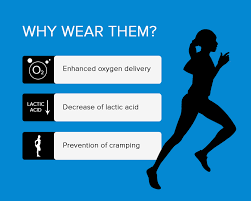
Researchers have claimed there are benefits from wearing compression socks during sports and other physical activities.
There are several advantages to using running compression socks, such as:
1. Better Performance
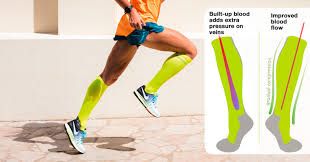
For a more effective workout performance, the body needs effective circulation. This means proper removal of metabolic waste products, like lactic acid, and quick transportation of de-oxygenated blood to the heart to become oxygenated.
When running, the legs and feet repeatedly hit the ground, taking up energy and using muscle strength. Compression socks ensure proper circulation which would help reduce muscle fatigue and improve waste removal.
2. Enhanced Muscular Stability
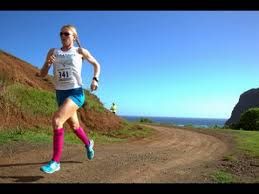
Athletes need muscular stability in their legs as this is where they exert most of their body weight when running. During a run, the continuous lateral motion may cause decreased stability and muscular efficiency. Running compression socks can reduce risk of injury and enhance muscular stability.
3. Maintains Warmth in Cold Weather
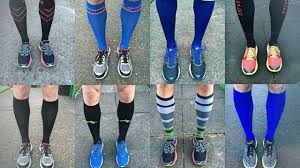
Wearing compression socks during an outdoor run when the weather is cold can help keep your legs and feet warm as well as provide protection from the elements.
4. Keeps Legs and Feet Dry
Compression socks for running tend to be made of nylon or a form of polyester. These fibers are breathable so that it does not retain moisture and odor. More so, they help you stay dry as they are designed to wick moisture away from your skin onto the outer surface.
5. Provides Protection for Trail Runners
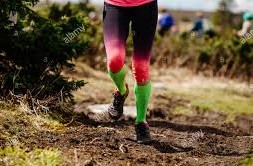
Running on outdoor treks and trails can be risky as its rugged terrain and exposure to nature can cause a runner to trip and fall, get scratched by thorns or bushes, get bitten by insects or come in contact with plants such as poison ivy.
Compression socks are tightly woven to protect the skin from direct contact with nature and can help prevent deep cuts or scrapes.
6. Reduced Risk of and Quicker Recovery from Injuries
Runners tend to suffer different types of injuries, such as plantar fasciitis, shin splints, achilles tendonitis, calf sprains or strains, metatarsal stress fractures, and so on. Injuries need time to heal, but can recover quicker with the help of compression socks by enhancing blood flow to the injured area. Compression socks can also prevent these injuries from occurring in the first place.
7. Quicker Recovery from Strenuous Workouts and Races
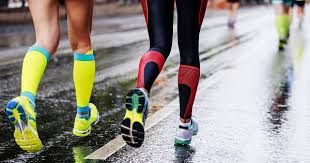
Having adequate rest after a workout is important for muscle repair and growth. Compression socks can help speed up post-workout recovery by ensuring enough blood flows to fatigue muscles.
After a workout session, inflammation helps repair any damages or strain on the muscles. Inflammation is necessary during recovery and its residual effects, which include swelling and aches, can be reduced by increasing the flow of blood in the affected areas. Graduated compression helps to increase blood flow to the calves, thereby improving muscle recovery and reducing leg fatigue.
8. Reduced Muscular Cramping and Soreness
Muscle cramps, aches and soreness is common after runs or any other physical activity. Compression socks have a way of reducing this cramping and soreness by constricting the arteries and veins in the legs to improve blood flow.
How to Choose the Best Compression Socks for Running
It is important to choose a pair of compression socks that meets your needs for running.
Here are some tips to consider:
1. Style
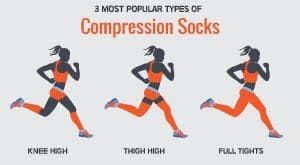
Choose a style you will be comfortable running in. Compression socks come in different lengths, such as ankle-high, knee-high, and thigh-high. Most runners prefer to go for the knee-high style which covers your feet to just below the knees to offer maximum support and protection.
2. Measurement
Measure your feet and legs to find the right size for you. Measure the widest part of your calves if you are seeking knee-high running compression socks. Knowing your shoe size would also be beneficial. A combination of your calf measurement and shoe size will give you the best compression sock size; compression socks should not be too tight or too loose as this can result in discomfort and ineffective results.
3. Compression Level
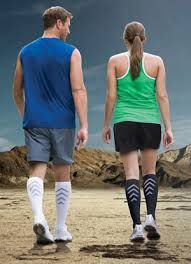
If uncertain which compression level is best for you, it is recommended that you consult with a doctor or health professional. There are various compression levels available, such as:
- 8 to 15 mmHg: This works great if you want to relieve minor swelling or need to protect your legs from blisters and the elements.
- 15 to 20 mmHg: This compression level is the most used by professional and regular runners. This helps prevent the occurrence of and provides relief from minor varicose veins and deep vein thrombosis.
- 20 to 30 mmHg: This is for people who need to prevent and relieve moderate to severe cases of varicose veins, edema, and deep vein thrombosis.
- 30 to 40 mmHg: This works great for preventing deep vein thrombosis, treating severe edema, and preventing or relieving severe varicose veins.
4. Padding and Calf Support
As a runner, it would be beneficial to choose compression socks with extra padding. This padding will help to absorb shock and reduce risk of getting blisters. Additionally, it will protect your feet and lower legs while reducing muscular vibrations.
Calf support will help to keep your muscles stable to prevent muscular oscillations. The bands of the socks should be comfortable under the knee so as not to completely cut off circulation around the area.
Popular Articles on ComproGear
What Level of Compression Socks Do I Need? Compression Stockings Pressure Levels
Common Features of the Best Compression Socks for Running
Here are several features common among the best compression socks that can help improve your running:
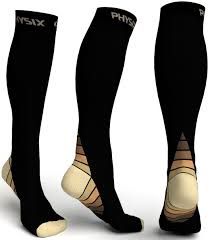
1. Made with Top-Notch Compression Technology
- Designed with a gradient compression of 20-30 mmHg to give an athletic fit, make them denser, better fitting, and more durable.
- Arch to calf is engineered with top-notch compression technology that offers support to the calf muscle. This helps boost circulation of blood to optimize performance and reduce recovery time.
- Designed to last while offering maximum comfort. Their vascular toning is excellent and well stitched so they are easy to wash and maintain without losing their compression.
2. Has Graduated Compression for Better Blood Circulation
- Specially designed to offer optimal compression when running.
- Features ultra-zone ribbing that helps to stabilize the arch and ankle of runners and other athletes.
- Graduated compression helps reduce risk of blood clotting and development of circulatory issues in the legs, such as varicose veins and edema.
3. Provides Maximum Support and Comfort with High-Quality Materials
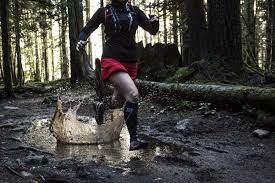
- Designed to be flexible and soft to maximize comfort for long use, with a 360-degree stretch.
- Has moisture-wicking and odor prevention features .
- Made from materials, such as nylon and cotton, to ensure lightness and breathable for the skin.
- Contains durable fabric, such as spandex and polyester, for a tougher build.
- Has cushioning or padding in the heels and soles of the feet to absorb weight and shock.
- Has good stitching.
4. Easy Maintenance, Functional and Versatile
- With good-quality material, these should be easy to wash, whether by machine or hand.
- Can be used for non-sports-related activities, such as recreational activities or work.
- Usable as part of daily wear attire.
Conclusion
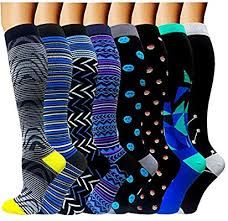
Running compression socks help boost athletic performance by ensuring proper blood circulation, reduces muscle fatigue, and quickens recovery post-exercise. So, when you are looking for where to get a pair of these high-quality compression socks for running, think of ComproGear!
